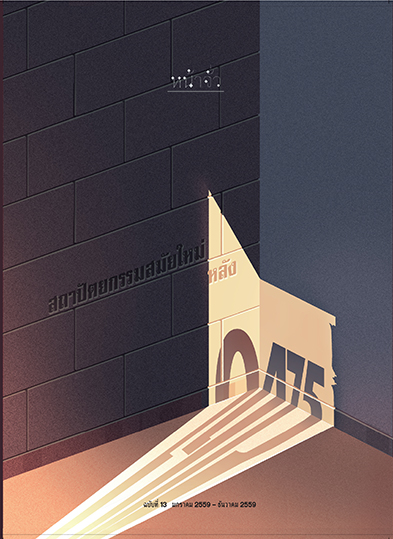ย้อนอ่านสถาปัตยกรรมตึกแถวในถนนท่าแพ : เส้นทางของความทันสมัยเมืองเชียงใหม่/ Re-reading Architecture of Row-Houses in Thapae Road : a Passage of Chiang Mai’s Modernization
Main Article Content
Abstract
บทคัดย่อ
บทความชิ้นนี้มีวัตถุประสงค์ย้อน “อ่าน” ถนนท่าแพและสถาปัตยกรรมตึกแถวที่ปรากฏในถนนท่าแพ ในฐานะที่เป็นหลักฐานชั้นต้นทางประวัติศาสตร์ที่จะช่วยให้เราได้ขยายความถึงการเปลี่ยนแปลงที่เกิดขึ้นตามยุคสมัย และวิเคราะห์การขยายตัวทางระบบเศรษฐกิจและระบบทุนนิยมที่เกิดขึ้นจากอำนาจของพ่อค้าชาวจีนในเมืองเชียงใหม่ ซึ่ง “ตึกแถว” สามารถสะท้อนให้เห็นถึงการเปลี่ยนแปลงในถนนเส้นนี้ โดยมีกระบวนวิธีวิจัย คือ (1) ระบุและเรียบเรียงความต่อเนื่องทางประวัติศาสตร์ของการเกิดขึ้นของย่านเศรษฐกิจการค้าของถนนท่าแพ ซึ่งเป็นจุดเริ่มต้นของตึกแถวบนถนน (2) วิเคราะห์และเชื่อมโยงการเปลี่ยนแปลงเข้าสู่การขยายตัวเศรษฐกิจและขยับขยายพื้นที่ของชาวจีน (3) เก็บรายละเอียดของตึกแถวรูปแบบต่าง ๆ ที่เรียงรายกันอยู่สองข้างถนนตามยุคสมัยที่เปลี่ยนแปลงไป ทั้งข้อมูลทางรูปด้าน ตำแหน่งแห่งที่ของตึก รายละเอียดทางสถาปัตยกรรม องค์ประกอบและการตกแต่ง วัสดุในการก่อสร้างที่เปลี่ยนแปลงไปตามแต่ละช่วงเวลา ซึ่งแบ่งออกได้เป็น 4 ยุคสำคัญ ๆ คือ 1) ยุคเริ่มต้นราว พ.ศ. 2427 หรือในช่วงหลังจากที่สยามเซ็นสัญญากับอังกฤษฉบับที่ 2 2) ยุคของการเข้ามาของข้าหลวงเทศาภิบาลราว พ.ศ. 2440 ถนนท่าแพที่ถูกอ่านจากสายตาของเหตุการณ์ในยุคเทศาภิบาล ถนนที่เชื่อมต่อเข้ากับแม่น้ำปิง การตั้งต้นของพื้นที่ของข้าราชการสยาม การเปลี่ยนแปลงของการปกครองล้านนา ถนนที่เชื่อมเข้าสู่ระบบเศรษฐกิจสมัยใหม่ 3) ยุคทองของเศรษฐกิจชาวจีนราว พ.ศ. 2470-2500 ท่าแพที่ถูกอ่านจากสายตาของคนจีนที่ข้ามฝั่งมาจากวัดเกตคืบคลานเข้าสู่ย่านถนนท่าแพ และพ่อค้าที่กุมอำนาจทางเศรษฐกิจเริ่มเปลี่ยนมือจากเดิมที่เป็นพม่าและไทใหญ่มาเป็นของคนจีน มันคือถนนท่าแพกับความรุ่งโรจน์ของเศรษฐกิจชาวจีนที่สามารถปรับตัวและเอาตัวรอดได้ทั้งจากระบบการปกครองแบบสยามและแบบล้านนา และ 4) ยุคปัจจุบัน สิ่งที่งานวิจัยชิ้นนี้พบคือ ตึกแถวทำหน้าที่เป็นภาพตัวแทนของยุคสมัย ซึ่งในปัจจุบันเหมือนเป็นภาพปะติดปะต่อเรื่องราวในอดีต ตึกแถวในแต่ละยุคยังให้ภาพของผู้คนที่อาศัยและดำเนินชีวิตในถนนเส้นนี้ ซึ่งปัจจุบันภาพตัวแทนเหล่านี้กำลังเสื่อมถอย ไม่ได้รับการเหลียวแลและกำลังจะถูกรื้อทิ้งทำลาย
Abstract
The objective of this paper is to “re-read” Thapae Road, in particular its architecture of row-houses, which, can be regarded as an important piece of historical manifestation from which we can explore our past that reveals how Chiang Mai have gradually been modernized as well as the significant transformation of its economy into a capitalist society. Methodologically, this paper has primarily drawn into a historical investigation based on the transformation of Chiang Mai’s economy, which is believed to be the point where the row-houses were initiated, secondly the establishment of Chinese migrant and how they have become influential in the city also need to be focused, lastly the juxtaposition of different façades and locations illustrate a variety of compositions based on a diverse of architectural styles, ornaments and materials that have evolved over time has also be taken into account. Historical exploration of this paper is divided into four periods (1) Thapae Road in the beginning (1884) or after the implementation of the second treaty between Bangkok and Britain; (2) Thapae Road in the period of the Siam intendance (1897), where Thapae road can be read as an area of Siam intendance along River Ping and the connection towards a new era of modern economy; (3) Thapae Road in the period of up-rising from Chinese merchants (1927-1947), which during this period the Chinese merchants were able to develop much stronger relations with Siam and adapted themselves into a new political system; and lastly (4) Thapae Road nowadays (2016) which is when we read Thapae Road through the current situation in what can be perceived as a diversity of culture awaiting to be polished, conserved. The finding is the row-houses in Thapae road can be regarded as a reflection of modernity. They function as a piece of collage informing people of the history, the transformation, the ways of living. Yet this functions gradually decline, neglect, and finally be destroyed.


